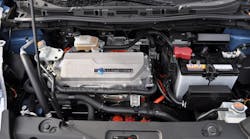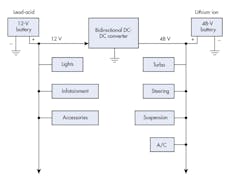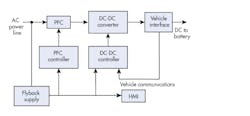Download this article in PDF format.
Automotive electrical systems are undergoing a major overhaul as a result of evolving vehicle powertrains and related systems. Three major considerations are the new 12-V plus 48-V electrical systems, complex multiple charging systems in electric vehicles (EVs) and plug-in hybrid EVs (PHEVs), and the growing demand for better sensors to manage the increasingly complex powertrains. Texas Instruments is addressing all of these requirements.
Sponsored Resources:
- Bridging 12 V and 48 V in dual-battery systems
- Taking charge of electric vehicles
- Basic considerations for sensors in powertrain
12/48-V Systems
Auto manufacturers are beginning to roll out new vehicles that incorporate an updated electrical system based on the addition of a 48-V battery. Over the past years, the constant stream of new electronic systems and features has basically overwhelmed the traditional 12-V battery and system.
The new electrical system not only accommodates all of the new current loads, but also permits other larger features and equipment to be added. The result is a vehicle that’s safer and more convenient and offers greater performance. The electronic subsystems powered by the 48-V source will deliver those improvements.
The new automotive electrical system has two power buses—one from the 12-V battery and another from the 48-V battery. The 12-V system powers the lighting, infotainment, and convenience devices like wipers, windows, doors, seats, and mirrors. The 48-V system takes on the heavy loads, such as the starter generator, air-conditioning compressors, active chassis control, electric super chargers or turbo chargers, as well as various pumps. Overall, the new 48-V addition provides an extra 10 kW of power with sufficient excess to handle future useful and desirable subsystems and devices.
Only a few of the latest vehicles have the new 48-V systems. Audi has its A6 model and Fiat Chrysler offers its RAM 1500 pickup with this system. And Volkswagen and Mercedes Benz will soon deliver new vehicles with this addition. U.S. manufacturers have models under development; you will see the new 48-V features gradually emerge vehicle by vehicle over the coming years.
Adding the new 48-V system doesn’t make the vehicle a hybrid or full electric. Most cars will continue to use the standard internal combustion engine (ICE). But the new 48-V power will help improve fuel savings with a revised stop/start system as well as more efficient electric turbochargers.
System Setup
The basic dual-voltage system is illustrated in Figure 1. The 12-V lead-acid battery is usually mounted at the front of the vehicle while the lithium-ion 48-V battery is located at the rear. The primary management and control is accomplished with a bidirectional dc-dc converter that can transfer power between the batteries. One system is able to deliver energy to supplement the other or either battery can charge the other.
The buck-boost dc-dc converter can be implemented with Texas Instruments’ LM5170-Q1 IC, a multiphase bidirectional current controller. It monitors and controls the current flow between the 12- and 48-V systems. This special device provides bidirectional current regulation to 1% and overvoltage protection.
Taking Charge of Charging
PHEVs and full-electric EVs have an entirely different electrical system. The heart of these vehicles is the high-voltage battery and the accompanying battery management system (BMS). The HV batteries deliver 400 to 800 V to power the electric motors that drive the vehicle.
The main technical challenge is understanding and implementing an effective battery charging system. As a first step, learn the differences between on-board and off-board chargers, how charging stations interact with on-board chargers and EV battery management systems, and how isolation factors into system design.
All PHEVs and EVs have an onboard charger (OBC). This unit connects to the ac power line and generates the dc for charging the battery. The ac source may be at home in the garage or at a local charging station. Home ac can be either 120 V or 240 V. With the low-voltage input, it can take 12 to 17 hours for a full recharge. Using an available 240-V line greatly reduces charge time to about four to eight hours. Charging stations are usually called electric vehicle service equipment (EVSE).
EVSE chargers are designated by their “level.” For instance, 120-V OBCs are Level 1, and 240-V OBCs are designated Level 2. A generic block diagram of a charger (OBC or other) Level 1 OBC is shown in Figure 2.
The 120-V ac input drives a half-bridge power factor correction (PFC) that produces a dc output. That dc voltage drives a dc-dc converter, which produces the voltage that’s sent to the vehicle interface to charge the battery. The PFC and dc-dc circuits each have an MCU controller and gate-drive circuits. Note that a simple flyback power supply develops the lower voltages to power the MCUs and related circuits.
A Level 3 dc charger arrangement is similar with a three-phase ac input that drives a PFC circuit, which in turn drives the high voltage dc-dc converter that charges the HV battery.
Level 3 chargers are off-board chargers (EVSE) that typically can only be found at standard charging stations. These EVSEs bypass the OBC and deliver HV dc directly to the HV battery via the BMS.
Note the human-machine interface (HMI) that includes a display, keyboard, and full monitor, control and programming functionality.
Making Sense of Sensors
The modern automobile is loaded with all types of sensors. The largest collection of these sensors belongs to the powertrain (engine + transmission). The new car buyer will typically get an ICE. A much smaller group of buyers will go for a PHEV, while an even smaller group will take the plunge with full EVs.
ICE vehicles probably use the most sensors because of the need to monitor and control substances to minimize undesirable emissions. Otherwise the objective of the sensors is to provide feedback to control systems that will improve efficiency, convenience, and performance.
Virtually every possible type of sensor can be found in modern vehicles. Yesterday’s vehicles had NO sensors, but today, the average car or truck incorporates dozens of them. Some of these sensors include:
- Temperature: Thermocouples are widely used in high-temperature applications. However, for less critical and lower-temperature situations, improved thermistors or solid-state sensors are employed because of their superior linearity.
- Pressure: Variable capacitance or variable resistance.
- Fluid level and concentration: Ultrasonic or capacitive-based.
- Position: They provide speed, angle, velocity, and on/off condition
- Exhaust: Chemical-based, RF, mandated to measure emissions.
- Current: Used in virtually all electrical devices and electronic subassemblies in the 12-, 48-, or 400- to 800-V ranges.
Keep in mind that the goal is improving the powertrain design as an effective way to reduce emissions. Sensors play an integral role in electrifying vehicles and creating efficient powertrains.
Sponsored Resources:


